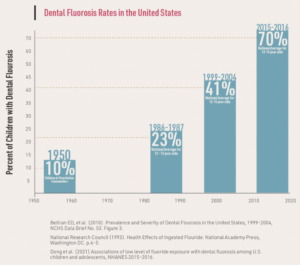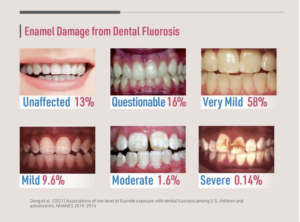CDC Data Shows More US Children Are Overexposed to Fluoride Than Ever Before
“Common sense should tell us that if a poison circulating in a child’s body can damage the tooth-forming cells, then other harm also is likely.” – Dr. John Colquhoun (1997).
Government data shows that tens-of-millions of U.S. residents have visible signs that they were overexposed to fluoride during childhood development. The US Centers For Disease Control’s (CDC) National Health and Nutrition Examination Survey (NHANES) has consistently found skyrocketing rates of dental fluorosis.
The CDC reported that 41% of adolescents (12 to 15 years of age) had dental fluorosis in 2004 (Beltran et al., 2010). At the time, this was an increase of over 400% from the rates found 60 years prior. The 2012 survey then found that the rate jumped significantly to 65+% of adolescents with dental fluorosis (Neurath et al., 2019).
Now, according to two recent studies, the fluorosis rates have continued to climb even higher. Data from the NHANES 2015-16 survey found that the prevalence of dental fluorosis was 70% in U.S. children according to both (Dong et al., 2021) and (Hung et al., 2023). Dr. Hung’s team also found that in some areas of the U.S.–as measured in the NHANES 2013-14 survey–up to 87.3% of adolescents exhibited some degree of fluorosis.

Dental fluorosis is a permanent tooth enamel defect caused by excessive fluoride intake during early childhood development. It appears as white spots or lines in milder cases and pitted and stained enamel in more severe cases, weakening the teeth and resulting in increased decay.
Children with dental fluorosis can suffer significant embarrassment and anxiety over the appearance of their teeth. No matter how much they might brush and floss, the fluorosis stains do not go away. In cases of severe fluorosis, a child may be perceived as having “dirty” or “rotten” teeth, which can cause significant damage to a child’s self esteem and emotional well-being. Even “mild” fluorosis — particularly when present on the front two teeth — can be highly objectionable.
Although fluorosis can be cosmetically treated, the damage to the enamel is permanent. More importantly, fluorosis is a biomarker of overexposure to fluoride during a critical time of childhood development, particularly for the brain.
Ingesting fluoridated water — particularly in reconstituted infant formula — and processed foods made with fluoridated water are recognized as the primary sources of exposure, though swallowing toothpaste and fluoride prescriptions also contribute.
A 2015 review of the practice of fluoridation by the Cochrane Collaboration, the gold standard for evidence-based reviews of health interventions, found that “there is a significant association between dental fluorosis (of aesthetic concern or all levels of dental fluorosis) and [water] fluoride level.”
This means that the teeth of millions of children, teens, and adults have already been damaged by overexposure to fluoride during their first 8 years of life, and the CDC, along with the other promoters of fluoridation are fully aware.

However, the teeth are not the only tissues in the body that are harmed by or accumulate fluoride. There is now a large body of government-funded studies linking early life exposure to neurotoxicity, including during infancy.
NHANES data have been used in recent published peer-reviewed studies to link fluoridated water to a number of additional side effects, including earlier onset of menstruation for black teens (Malin et al., 2021), low birth weight for Hispanic newborns (Arun et al., 2022), lower testosterone in males and lower sex steroid hormones in females (Huang et al., 2020), sleep disorders in adolescents (Malin et al., 2019 & Cunningham et al., 2021), increased uric acid levels in blood (Wei et al., 2021), a two-fold increase in pediatric bone fractures (Lindsay et al., 2023), increased cellular markers of inflammation in teens (Besten et al., 2022), kidney and liver impairment in adolescents (Malin et al., 2019), and higher plasma fluoride levels in children with lower renal function (Danzinger et al., 2022).
The Fluoride Action Network is leading the way in bringing this government data to the attention of state legislators, local decision makers, the media, and the public in an effort to stop this easily preventable epidemic of overexposure. Water departments just need to turn off their fluoridation chemical injection apparatus.
With your help, we hope to do even more in 2024 to amplify the voices of the victims of fluoridation. Tens of millions of U.S. citizens can see the side-effects of this practice simply by looking in the mirror, but most have no idea that fluoride caused the enamel damage they see every day on themselves and their peers. We would like to educate and activate as many of these potential allies as possible. Will you help us?
Thank you,
Stuart Cooper, Executive Director, Fluoride Action Network
